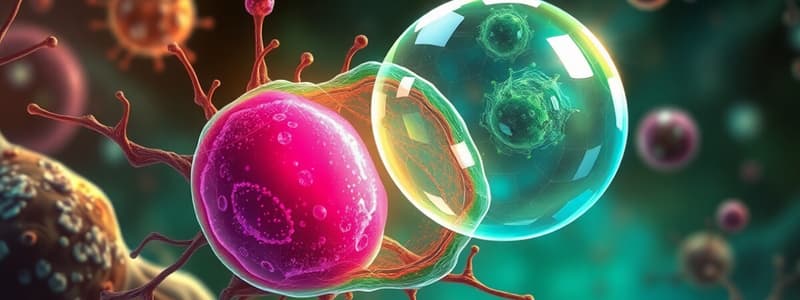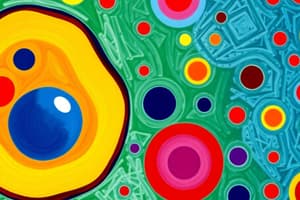Podcast
Questions and Answers
What is the smallest structural and functional unit of organisms?
What is the smallest structural and functional unit of organisms?
- Cell (correct)
- Organism
- Tissue
- Organ
Which characteristic is NOT associated with cells?
Which characteristic is NOT associated with cells?
- Senses environmental changes
- Capable of self-regulation
- Always multicellular (correct)
- Can duplicate
What type of cells lack a true nucleus?
What type of cells lack a true nucleus?
- Eukaryotic cells
- Animal cells
- Plant cells
- Prokaryotic cells (correct)
Which of the following is true about prokaryotic cells?
Which of the following is true about prokaryotic cells?
The region of the cell that contains the DNA is called the:
The region of the cell that contains the DNA is called the:
Which statement about the cytoplasm is correct?
Which statement about the cytoplasm is correct?
Which of the following describes a similarity between eukaryotic and prokaryotic cells?
Which of the following describes a similarity between eukaryotic and prokaryotic cells?
Which of the following structures is found in eukaryotic cells but not in prokaryotic cells?
Which of the following structures is found in eukaryotic cells but not in prokaryotic cells?
What term refers to the area inside of a cell?
What term refers to the area inside of a cell?
What directs proteins to the endoplasmic reticulum (ER)?
What directs proteins to the endoplasmic reticulum (ER)?
What is the primary function of the Golgi apparatus?
What is the primary function of the Golgi apparatus?
Which structural feature is unique to the Golgi apparatus?
Which structural feature is unique to the Golgi apparatus?
What happens to products as they move through the Golgi apparatus?
What happens to products as they move through the Golgi apparatus?
What could be a consequence of defects in Golgi function?
What could be a consequence of defects in Golgi function?
What is the role of transport vesicles in relation to the Golgi apparatus?
What is the role of transport vesicles in relation to the Golgi apparatus?
Which of the following describes the structure surrounding the nucleus?
Which of the following describes the structure surrounding the nucleus?
What is the primary function of the nucleolus?
What is the primary function of the nucleolus?
What type of chromatin is less compact and frequently expresses genes?
What type of chromatin is less compact and frequently expresses genes?
Which organelle is NOT classified as a membranous organelle?
Which organelle is NOT classified as a membranous organelle?
Which component of the nucleus is involved in maintaining the shape and structure of DNA?
Which component of the nucleus is involved in maintaining the shape and structure of DNA?
During which process do chromatin fibers condense into chromosomes?
During which process do chromatin fibers condense into chromosomes?
What is the liquid substance contained within the nucleus called?
What is the liquid substance contained within the nucleus called?
Which of the following organelles are involved in the synthesis, storage, and export of molecules?
Which of the following organelles are involved in the synthesis, storage, and export of molecules?
What structure forms the core of DNA wrapped around histone proteins?
What structure forms the core of DNA wrapped around histone proteins?
Which of the following organelles is responsible for processing and packaging proteins?
Which of the following organelles is responsible for processing and packaging proteins?
What are anti-nuclear antibodies (ANA) associated with?
What are anti-nuclear antibodies (ANA) associated with?
Which of the following is NOT a function of the cytoplasm?
Which of the following is NOT a function of the cytoplasm?
What distinguishes rough endoplasmic reticulum from smooth endoplasmic reticulum?
What distinguishes rough endoplasmic reticulum from smooth endoplasmic reticulum?
Which of the following processes is primarily associated with the smooth endoplasmic reticulum?
Which of the following processes is primarily associated with the smooth endoplasmic reticulum?
Which function is NOT performed by the rough endoplasmic reticulum?
Which function is NOT performed by the rough endoplasmic reticulum?
What component does the endoplasmic reticulum lack that differentiates smooth ER from rough ER?
What component does the endoplasmic reticulum lack that differentiates smooth ER from rough ER?
What is one of the key roles of the smooth endoplasmic reticulum?
What is one of the key roles of the smooth endoplasmic reticulum?
What type of chemical substances does the cytoplasm primarily contain?
What type of chemical substances does the cytoplasm primarily contain?
Which organelles are synthesized or directed by the rough endoplasmic reticulum?
Which organelles are synthesized or directed by the rough endoplasmic reticulum?
Which of the following substances is sequestered by the smooth endoplasmic reticulum?
Which of the following substances is sequestered by the smooth endoplasmic reticulum?
What is the primary function of the nucleus in a eukaryotic cell?
What is the primary function of the nucleus in a eukaryotic cell?
Which type of cell is described as having no nucleus and is incapable of division?
Which type of cell is described as having no nucleus and is incapable of division?
What is the consequence of polynucleated cells being formed during development in humans?
What is the consequence of polynucleated cells being formed during development in humans?
Which of the following is a rare tumor characterized by the presence of multinucleated giant cells?
Which of the following is a rare tumor characterized by the presence of multinucleated giant cells?
What role do RNA polymerases play in the nucleus?
What role do RNA polymerases play in the nucleus?
What happens to the nucleus during cell division?
What happens to the nucleus during cell division?
Defective nucleoli have been linked to several neurodegenerative disorders. Which of the following is NOT commonly associated?
Defective nucleoli have been linked to several neurodegenerative disorders. Which of the following is NOT commonly associated?
Which of the following macromolecules is actively transported across the nuclear membrane?
Which of the following macromolecules is actively transported across the nuclear membrane?
What characteristic is true of the giant multinucleated cells that sometimes accompany inflammation?
What characteristic is true of the giant multinucleated cells that sometimes accompany inflammation?
What is the function of transcription factors within the nucleus?
What is the function of transcription factors within the nucleus?
Flashcards are hidden until you start studying
Study Notes
Cell Theory
- Cells serve as the smallest structural and functional unit of all organisms.
- Every organism is made up of one or more cells.
- Cells arise only from preexisting cells through division.
Characteristics of a Cell
- Cells store genetic information and can make and utilize energy.
- They possess movement capabilities and can sense changes in their environment.
- Cells can reproduce, repair themselves, grow, and develop.
- Homoeostasis is maintained through self-regulation.
- Cells synthesize various molecules, including proteins, carbohydrates, fats, and nucleic acids.
Types of Cells
- Prokaryotic Cells: Simple, smaller (<10 µm), lack a true nucleus and membrane-bound organelles, contain circular DNA, and consist of unicellular organisms.
- Eukaryotic Cells: Larger (10-100 µm), have a true membrane-bound nucleus and organelles, contain linear DNA associated with proteins, and can be unicellular or multicellular (includes animal and plant cells).
Prokaryotes vs. Eukaryotes
- Prokaryotes: Asexual reproduction via binary fission, small ribosomes, and single circular DNA.
- Eukaryotes: Reproduction through mitosis and meiosis, larger ribosomes, multiple linear DNA strands.
Three Important Cell Regions
- Cell Membrane: Outermost boundary controlling movement in and out of the cell.
- Nucleus: Control center containing DNA, directing cell function.
- Cytoplasm: Jelly-like substance where organelles are suspended and biochemical reactions occur.
Cell Organelles
- Membranous Organelles: Include endoplasmic reticulum, mitochondria, Golgi apparatus, and lysosomes.
- Non-Membranous Organelles: Include ribosomes and cytoskeletal structures.
Nucleus Structure
- Comprised of the nuclear membrane (double-layer with pores), nucleoplasm (liquid similar to cytosol), nucleolus (synthesizes ribosomes), and chromatin (DNA and proteins).
- Chromatin condenses into chromosomes during cell division.
Chromosome Structure
- Composed of nucleosomes (DNA wrapped around histone proteins), solenoids (coiled nucleosomes), and chromatin fibers.
Anucleated and Polynucleated Cells
- Anucleated cells lack a nucleus (e.g., mature red blood cells).
- Polynucleated cells contain multiple nuclei (e.g., skeletal muscle cells and giant multinucleated cells associated with inflammation).
Nucleus Functions
- Stores DNA and directs cellular activities, including DNA replication and transcription into RNA.
- Contains various proteins that mediate transcription and regulate gene expression.
- Macromolecules are actively transported across the nuclear membrane via nuclear pore complexes.
Disorders Related to the Nucleus
- Defective nucleoli linked to neurodegenerative disorders, including Alzheimer's and Huntington's.
- Autoimmune diseases associated with anti-nuclear antibodies affecting chromatin organization.
Cytoplasm Functions
- Medium for biochemical reactions and cellular processes.
- Contains enzymes, substrates, and organelles involved in functions like protein synthesis.
Endoplasmic Reticulum (ER)
- A network of membranes consisting of rough and smooth ER.
- Rough ER is involved in protein synthesis and sending proteins to Golgi apparatus; smooth ER synthesizes lipids, detoxifies substances, and manages calcium ion storage.
Golgi Apparatus
- Acts as a "finishing factory" for ER products, consisting of flattened vesicles and transporting materials.
- Modifies, sorts, and ships products in vesicles for secretion or storage.
- Errors in Golgi function can lead to various disorders, including congenital glycosylation disorders and certain cancers.
Importance of Golgi Apparatus Function
- Essential for proper protein localization and cellular functions.
- Mistakes in protein sorting can lead to dysfunctional cellular processes.
Studying That Suits You
Use AI to generate personalized quizzes and flashcards to suit your learning preferences.




